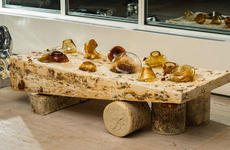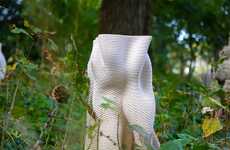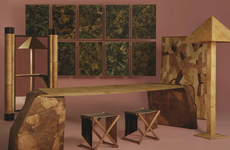
Blast Studio 3D-Printed a Columns that Can be Harvested for Mushrooms
Elena Rahman — January 18, 2022 — Eco
References: blast-studio & dezeen
Blast Studio created a column from mycelium that boasts a dual purpose. The studio 3D-printed the column using living mycelium. The hope is that the column could be harvested for mushrooms before serving as a structural building element, giving it a dual function.
The column is two meters high and is dubbed the Tree Column due to its tree trunk shape. The Tree Column boasts an undulating structure algorithmically designed to enhance its structural capacity while providing an optimal growing condition for mycelium. Currently, the innovative structure is on display at London's Design Museum.
The designers constructed the Tree Column by mixing mycelium with waste coffee cups that were collected throughout London, England. It was printed using a similar process to 3D printing with clay.
Image Credit: Blast Studio
The column is two meters high and is dubbed the Tree Column due to its tree trunk shape. The Tree Column boasts an undulating structure algorithmically designed to enhance its structural capacity while providing an optimal growing condition for mycelium. Currently, the innovative structure is on display at London's Design Museum.
The designers constructed the Tree Column by mixing mycelium with waste coffee cups that were collected throughout London, England. It was printed using a similar process to 3D printing with clay.
Image Credit: Blast Studio
Trend Themes
1. Dual Purpose 3D Printing - The use of 3D printing to create products that can serve multiple purposes, such as Blast Studio's mycelium column that can be both harvested for mushrooms and used as a structural element.
2. Sustainable Material Innovation - The development and use of sustainable materials like mycelium and waste coffee cups in 3D printing, to create environmentally-friendly products while reducing waste.
3. Algorithmic Design for Structural Capacity - The use of algorithms to design structures that are both aesthetically pleasing and structurally sound, as seen with the undulating design of Blast Studio's mycelium column.
Industry Implications
1. Architecture - Architecture firms can use sustainable materials and advanced 3D printing techniques to create eco-friendly and multi-purpose buildings like Blast Studio's mycelium column.
2. Food and Agriculture - Companies in the food and agriculture industry can explore the use and cultivation of mycelium for food products, while also repurposing waste materials like coffee cups for growth mediums.
3. Manufacturing - Manufacturing companies can adopt algorithmic design and sustainable 3D printing techniques to create products with strong structural capacity, while reducing environmental impact through the use of eco-friendly materials like mycelium and waste products.
1.8
Score
Popularity
Activity
Freshness























